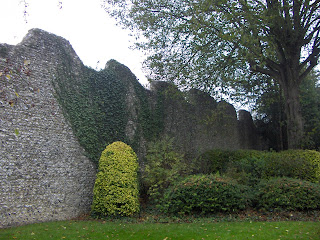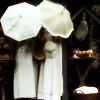
Thus end my dream of becoming Mrs. Corene Firth-Brown-Darcy. The lovely city of Winchester proved (after careful, painstaking examination) to be 100% Colin Firth Free. But then I read the chilling saga of It's Hard to Be Colin Firth and realized it was probably for the best.

Winchester's raison d'etre is the spectacular Winchester Cathedral that you can almost make out in the fog if you squint and cross your eyes like your trying to make out one of those ridiculous Magic Eye 3D pictures (which I suspect, weren't actually secret pictures at all but rather, a clever ploy to induce myopia in the populace sponsored by the Oculists of America).
Trust me, the Cathedral is there. All roads lead to it. All postcards feature it. All street signs urge you to go there and buy t-shirts.
Winchester Cathedral in all its Protestant glory.
When the Reformation rolled on down to Winchester, the angry proto-Protestants went around town destroying pretty things that reminded them of Catholicism to make their churches as dull as possible, like you do. And, while staring into the dead, cold eyes of the Grinning Unicorn of Sheer Unbridled Evil, I suddenly felt the urge to burn me some graven images.
If your tastes do not run in the Evil Unicorn vein, the only other reason to visit Winchester Cathedral is the grave of Jane Austen.
Jane Austen is buried under the floor and yes, I did walk over her grave several times to take a picture of this: Her tacky gilt sign that was erected by readers long after her death, who obviously spent all their good taste in literature and had none left over for the selection of tasteful memorial plaques.
SEASON of mists and mellow fruitfulness,
Close bosom-friend of the maturing sun;
Conspiring with him how to load and bless
With fruit the vines that round the thatch-eaves run
Conspiring with him how to load and bless
With fruit the vines that round the thatch-eaves run
...Where are the songs of Spring? Ay, where are they?
While barrèd clouds bloom the soft-dying day
And touch the stubble-plains with rosy hue...
- John Keats, Ode to Autumn
While walking past the river Itchen, John Keats was inspired to write his "Ode to Autumn."
While walking past the river Itchen, I was inspired to find the nearest rhubarb pie and eat it.
And this is why I don't write poetry.
Other sites of Winchester include "Arthur's" Round "Table." This faux tableau was built by order of Henry VIII whose likeness was used to paint to the portrait of "Arthur" to convince the Southerners that he was the descendant of the mythic king and so they could all just shut up and do exactly what he said.
The Southerners, having more than one brain cell between them, did not. Maybe if Henry had looked more like this:

Things might have turned out differently.
The grossly misnamed Wolversey Castle. I would be curious to find the Winchester County Council's definition of "castle" as what they have termed a castle is not remotely castle-like.
Things might have turned out differently.
This, my dear friends of the Winchester County Council, is a wall.
A really, boring wall.

Abbey House where Benedictine nuns waited out the French revolution, spending their time singing, dancing and snogging Christopher Plummer.

Winchester's tribute to Equus.

A slight hike up St. Giles seemed like a brilliant idea at the bottom of the hill...

At the top of the hill, not so much. I had forgotten that all important weather/sight seeing equation: Fog = You can't see things.
Narnia!
King Alfred whose only purpose in English history is as some sort of obscure reference to bread that no one can explain to me.















No comments:
Post a Comment